ASUS P5E3 Deluxe: X38 and DDR3 arrives... almost
by Gary Key on September 18, 2007 4:00 AM EST- Posted in
- Motherboards
ASUS P5E3 Deluxe Express Gate Features
One of the new features that ASUS is launching with this board is their Express Gate application that is based on Splashtop technology. Express Gate features a unique startup screen when the system is first booted. This technology allows you to continue the POST process into your operating system, enter the BIOS setup, and power down or restart the system. The current utilities allow the user to enter a built-in web browser or launch Skype provided an internet connection is available through one of the Gigabit LAN controllers or the 802.11n wireless connection. ASUS includes a windows based utility to update the current Express Gate program code and applets.
Startup / Exit
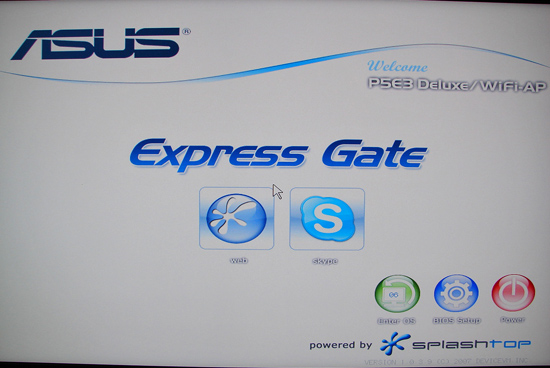
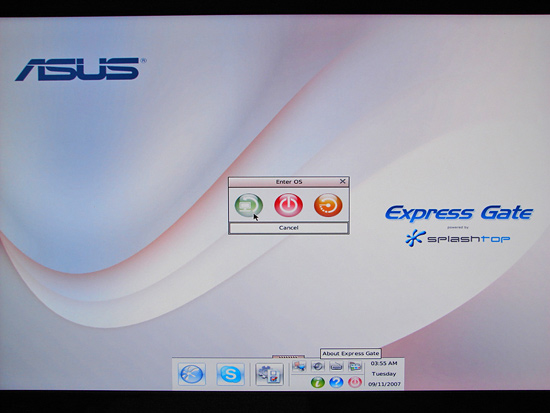
The top screenshot shows the startup screen with the bottom screenshot showing the exit options. Express Gate can be turned off in the BIOS if this application is not interesting to the user.
Configuration
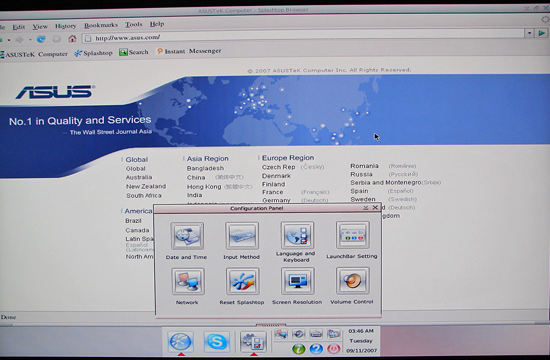
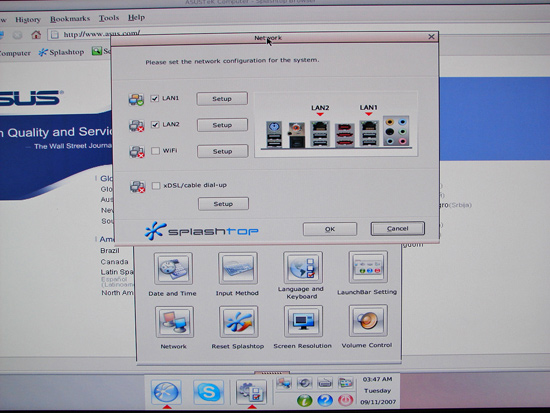
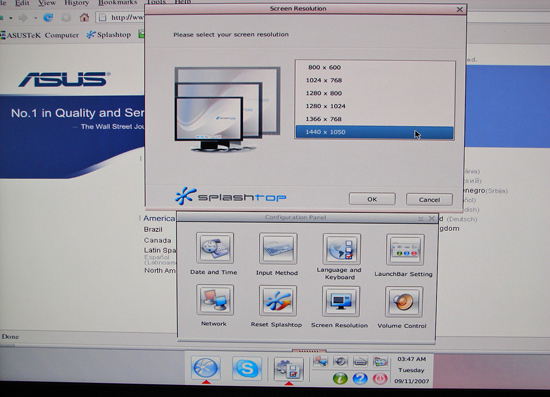
The setup and configuration of Express Gate was fairly straightforward with individual options for Date and Time, Input Devices, Language and Keyboard Layout, LaunchBar settings, Network configuration, Volume control, and Screen Resolution. Screen Resolution is limited to 1440x1050 currently but the ability to define the network connection is extensive.
Skype

During testing, our Skype connection worked perfectly during several extended conversations. The current code included will be updated before product launch and we will provide details on the final version at that time.
Web
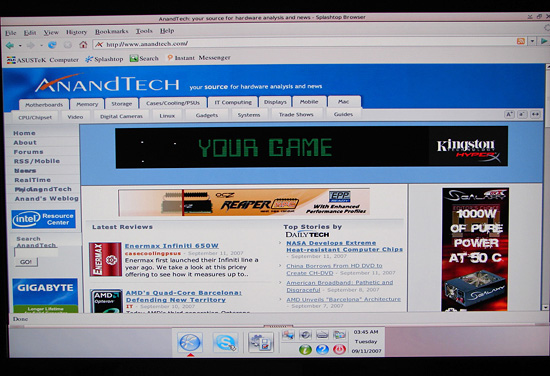
The browser is based on Splashtop technology and performed admirably in early testing. The current code release is being optimized along with additional browser features. We visited several websites and did not run into any layout or display issues in our initial testing with this applet. Adobe Flash is also supported within the browser.
One of the new features that ASUS is launching with this board is their Express Gate application that is based on Splashtop technology. Express Gate features a unique startup screen when the system is first booted. This technology allows you to continue the POST process into your operating system, enter the BIOS setup, and power down or restart the system. The current utilities allow the user to enter a built-in web browser or launch Skype provided an internet connection is available through one of the Gigabit LAN controllers or the 802.11n wireless connection. ASUS includes a windows based utility to update the current Express Gate program code and applets.
Startup / Exit


The top screenshot shows the startup screen with the bottom screenshot showing the exit options. Express Gate can be turned off in the BIOS if this application is not interesting to the user.
Configuration



The setup and configuration of Express Gate was fairly straightforward with individual options for Date and Time, Input Devices, Language and Keyboard Layout, LaunchBar settings, Network configuration, Volume control, and Screen Resolution. Screen Resolution is limited to 1440x1050 currently but the ability to define the network connection is extensive.
Skype

During testing, our Skype connection worked perfectly during several extended conversations. The current code included will be updated before product launch and we will provide details on the final version at that time.
Web

The browser is based on Splashtop technology and performed admirably in early testing. The current code release is being optimized along with additional browser features. We visited several websites and did not run into any layout or display issues in our initial testing with this applet. Adobe Flash is also supported within the browser.










60 Comments
View All Comments
Gary Key - Wednesday, September 19, 2007 - link
We do not disable services as we try our best to mimic the user experience. Obviously, clearing the Prefetch folder does not allow that to happen but it is the only way to get consistent results. Over time we have seen the benchmark scores move up to 3% when leaving Prefetch enabled, does not sound like that much, but we try our best to keep the benchmark variables under 0.5% within the test suite. Also, Vista has just about doubled the time it takes to run the benchmark test suite, if you ever had an issue sleeping, just watch WorldBench 6.0 run five times in a row.FireTech - Tuesday, September 18, 2007 - link
Gary where are the promised µATX and P35 round-ups?After 6+months, you've run out of credit at the excuses bank. It's time to deliver on your promises, then you can get back to the Intel launch parties....
Gary Key - Tuesday, September 18, 2007 - link
µATX G33 will be next Wednesday and will include the NV MCP73, the first P35 series will start this Friday with the Foxconn MARS board and the abit/Gigabyte mid-range boards late next week. The AMD µATX is scheduled on 10/2 with the budget P35 boards following on 10/5.FireTech - Wednesday, September 19, 2007 - link
Sorry Gary but these similar words are still fresh in my memory:Are these new dates set in stone?
Gary Key - Wednesday, September 19, 2007 - link
Still fresh in my memory also. ;-) Yes, the dates are set, the only one that might move a day or so is the second P35 article for late next week. AMD is going to have a Phenom/RD790 preview that I might have to attend next Thursday. Otherwise, the dates are good this time. Email me and I will explain the situation.JKing76 - Tuesday, September 18, 2007 - link
New chipset, great. Are we ever going to see the fucking micro-ATX roundup? And no, I don't count that bullshit "dedicated video is faster than integrated video" part 1 fluff.Nickel020 - Tuesday, September 18, 2007 - link
Hey, thanks for throwinf us a bone Gary! ;)I was wondering what the max FSB of the exact CPU used in the tests was when using P35 boards? Thats one of the biggest hopes that people have for teh X38, that it will allow higher FSBs for quads, because as of now, most people can't get over around 450 FSB on a P35 when using a quad.
Gary Key - Tuesday, September 18, 2007 - link
The max (stable) FSB of the Q6600 on the Blitz Extreme was 468, on the DFI P35-T2R (is an absolute knock out with the 9/13 beta bios) was 470, P5K Deluxe is 464, and abit IP35-Pro was 462. The X38, once mature, will really improve overclocking of the current processor lineup (until you hit the CPU FSB wall) but is really designed to shine with Penryn.However, I believe Intel has just about reached the limits of what they can do with the memory controller based on what we are seeing now, so stock performance is not going to vary that much from a P35 or even 680i/975x in most situations. It appears the BIOS spins are going to need a month or two to really extract the best performance out of the chipset, and DDR2 performance is not that impressive at this time. We will show numbers with DDR2-800 at 3-4-3-9 as a base and a really good P35 board is going to give some of these X38 boards a run for their money until you get the DDR2 speeds up around 1100.
My personal opinion is that the DDR2 X38 boards will quickly replace the upper end P35 boards in the market since the price points will be the same after the launch hysteria is over. Expect to see the P35 drop to the $75~$150 market only by early next year.
Nickel020 - Wednesday, September 19, 2007 - link
Thanks a lot for the reply Gary!You got me thinking again though, I was just going to sell my P35 DS3 and keep the P35 DQ6 for Penryn. But maybe I should sell the DQ6 now as long as it's worth something and use the DS3 until X38 Boards are somewhat mature and then upgrade (and sell the DS3).
Do you think X38 DDR2 Boards will have a significant overclocking & performance advantage over P35 boards with Penryn?
Gary Key - Thursday, September 20, 2007 - link
They are showing around a 5%~9% improvement currently, but I have not received a P35 optimized BIOS for Penryn yet, but then again, the X38 BIOS releases are still immature. We will know more in a couple of weeks I think but right now, unless you go DDR3, not seeing any real performance improvements with DDR2 on the retail X38 boards, a couple of percent here and there but the DFI P35-TR2 board is faster than the X38 DDR2 boards I have right now for single card GPU situations. Still waiting on another BIOS release or two before publishing the final numbers. ;-)